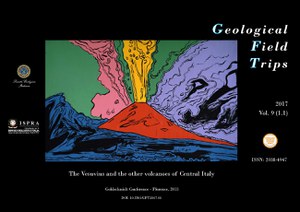The Vesuvius and the other volcanoes of Central Italy
Goldschmidt Conference - Florence, 2013
The field trip is devoted to the observation and discussion of the volcanological, mineralogical, and geochemical characteristics of the most famous/infamous leucite-bearing and -free ultrapotassic rocks and their associated shoshonites and calc-alkaline terms, generated by recycling of sediments within the upper mantle via subduction.
Indeed, Central Italy represents a unique geological area, characterised by alkaline to sub-alkaline volcanic rocks generated at destructive plate margin with typical orogenic geochemical signature though to be generated by recycling of sediments within the upper mantle.
The first aim of the field trip is the observation of Pliocene to Holocene volcanic rocks and their changing in geochemistry with time in relation to the geodynamic evolution of the Italian Peninsula and of the Apennine Chain will be shown.
During the first day you will climb the top of the Monte Vesuvius Volcano, walk around the rim of the “Gran Cono” crater, look at the leucite-bearing rocks of the Monte Vesuvius Volcano, walk over the 1944 AD eruption; visit the Oplontis Villa archaeological site and observe the Pompei eruption sequence.
During the second day you will leave Naples to Roccamonfina Volcano. On the way you will made a brief stop at the Phlegrean Field to observe its caldera and the solfatara activity. Once at Roccamonfina Volcano the caldera and the rocks of the intra-caldera activity are observed.
During the third day you will arrive to the Colli Albani Volcano to observe melilite-bearing ultrapotassic rocks, the Albano Lake volcanic succession and eventually the feature of the explosion crater. In the afternoon Stops it is possible to look at the famous “Tufo Lionato” and “Pozzolanelle” units of the Villa Senni eruption belonging to the caldera-forming volcanic sequence.
During the fourth day you will move to San Venanzo village, to observe kalsilite-bearing melilitic lavas, and then move to the nested Monte Cimino and Vico volcanoes to observe the passage from the older leucite-free (Cimino) to the younger leucite-bearing (Vico) ultrapotassic rocks, the polygenetic Vico caldera with its Monte Venere intra-caldera cone. In the afternoon the characteristics of the volcanic activity of the Vulsinian volcanoes are observed.
During the fifth day you will make Stops at the Torre Alfina, Radicofani and Monte Amiata volcanoes. During these Stops the lamproite-like rocks and xenoliths of the Torre Alfina Volcano, the neck and the variation from andesite to shoshonite at Radicofani Volcano, and the trachytic to latitic domes with high-K calc-alkaline affinity at Monte Amiata Volcano are observed.
DOI: 10.3301/GFT.2017.01

